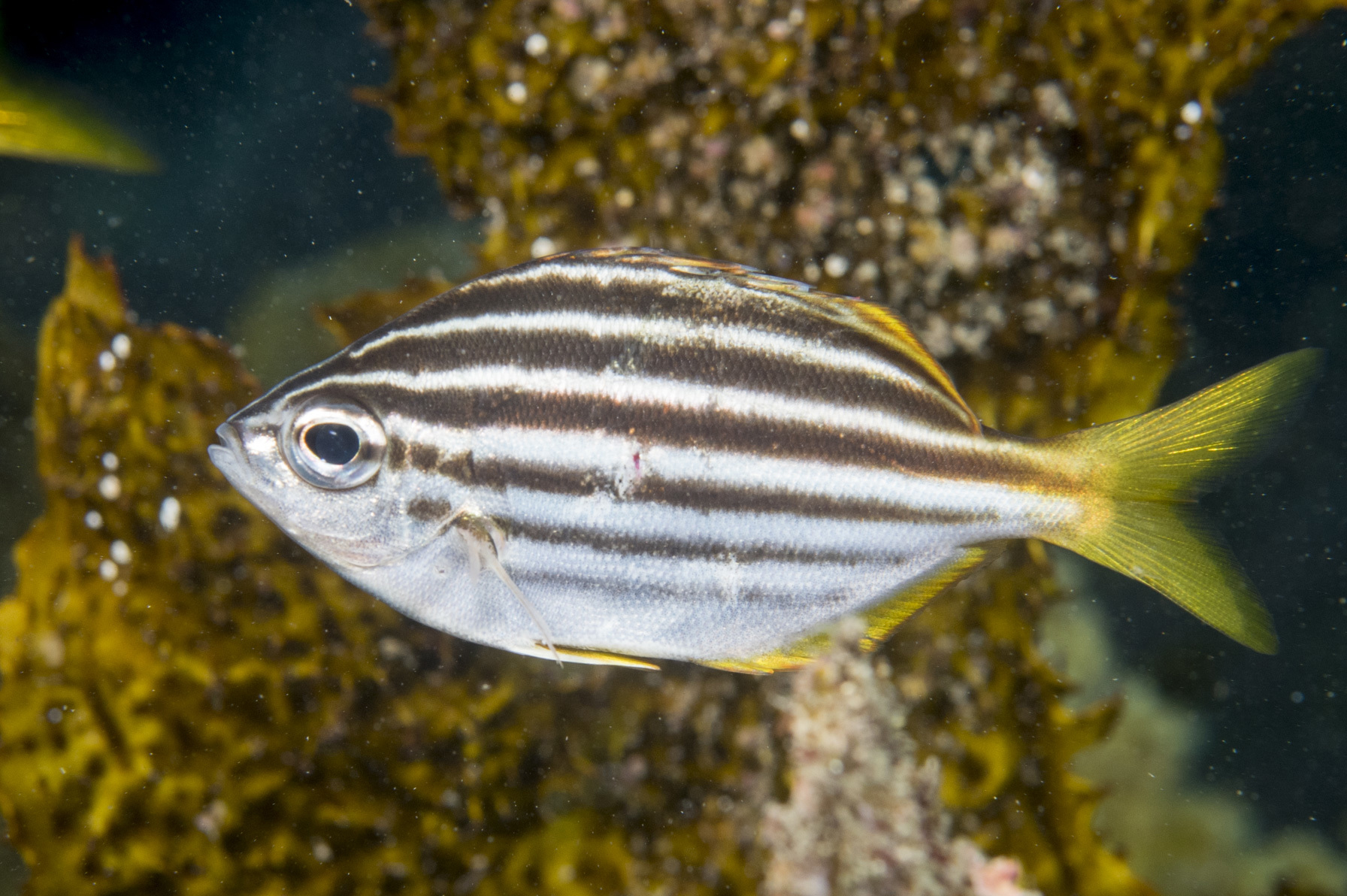Mado, Atypichthys strigatus (Günther 1860)

A Mado, Atypichthys strigatus, in Bushranger's Bay, Bass Point, New South Wales, June 2017. Source: Erik Schlogl / iNaturalist.org. License: CC by Attribution-NonCommercial
A silvery-white mado with about 6 dark brown or black horizontal stripes along the side and mostly yellow fins.
Mado, Atypichthys strigatus (Günther 1860)
More Info
|
Distribution |
Endemic to temperate waters of eastern and south-eastern Australia, from about Moreton Bay, Queensland, to Apollo Bay, Victoria, including northern and eastern Tasmania; also the Lord Howe Province in the Tasman Sea. Commonly seen on rocky reefs and around wharfs, jetties and pylons in coastal areas, harbours, bays and large estuaries, at depths of 0-30 m. This is one of the most common species on rocky reefs in New South Wales. |
|
Features |
Dorsal fin XI, 16-18; Anal fin III, 15-16; Pectoral fin 16; Pelvic fin I, 5; Caudal fin 17; Lateral line scales ~50. Body deep, compressed, head small, snout pointed, tail forked; dorsal fin single, long-based, middle-most dorsal spines the highest. |
|
Size |
To 25 cm. |
|
Etymology |
The specific name is from the Latin strigatus (= striped), in reference to the dark stripes along the side. |
|
Species Citation |
Atypus strigatus Günther 1860, Catalogue of the Fishes in the British Museum 2: 64. Type locality: Swan River, Western Australia [in error] |
|
Author |
Bray, D.J. 2023 |
|
Resources |
Mado, Atypichthys strigatus (Günther 1860)
References
Allen, G.R., Hoese, D.F., Paxton, J.R., Randall, J.E., Russell, B.C., Starck, W.A., Talbot, F.H. & Whitley, G.P. 1976. Annotated checklist of the fishes of Lord Howe Island. Records of the Australian Museum 30(15): 365-454 figs 1-2
Carpenter, K.E. 2001. Girellidae, Scorpididae, Microcanthidae. pp. 3297-3303 in Carpenter, K.E. & Niem, V.H. (eds). The Living Marine Resources of the Western Central Pacific. FAO Species Identification Guide for Fisheries Purposes. Rome : FAO Vol. 5 2791-3379 pp.
Edgar, G.J. 2008. Australian Marine Life: the plants and animals of temperate waters. Sydney : Reed New Holland 2nd edn, 624 pp.
Francis, M. 1993. Checklist of the coastal fishes of Lord Howe, Norfolk, and Kermadec Islands, southwest Pacific Ocean. Pacific Science 47(2): 136-170 figs 1-2
Fraser-Brunner, A. 1946. On the systematic position of a fish, Microcanthus strigatus (C. & V.). Annals and Magazine of Natural History 11 12: 462-468 figs 1-3
Glasby, T.M. & Kingsford, M.J. 1994. Atypichthys strigatus (Pisces, Scorpididae) - an opportunistic planktivore that responds to benthic disturbances and cleans other fishes. Australian Journal of Ecology 19: 385-394
Gomon, M.F. 2008. Families Monodactylidae, Arripidae, Kyphosidae, Girellidae, Microcanthidae, Scorpididae. pp. 596-607 in Gomon, M.F., Bray, D.J. & Kuiter, R.H. (eds). Fishes of Australia's Southern Coast. Sydney : Reed New Holland 928 pp.
Grant, E.M. 1991. Fishes of Australia. Brisbane : EM Grant Pty Ltd 480 pp.
Günther, A. 1860. Catalogue of the Fishes in the British Museum. Catalogue of the acanthopterygian fishes in the collection of the British Museum. Squamipinnes, Cirrhitidae, Triglidae, Trachinidae, Sciaenidae, Polynemidae, Sphyraenidae, Trichiuridae, Scombridae, Carangidae, Xiphiidae. London : British Museum Vol. 2 548 pp. See ref at BHL
Günther, A. 1862. Catalogue of the Fishes in the British Museum. Catalogue of the Acanthopterygii Pharyngognathi and Anacanthini in the collection of the British Museum. London : British Museum Vol. 4 534 pp.
Hutchins, J.B. & Swainston, R. 1986. Sea Fishes of Southern Australia. Complete field guide for anglers and divers. Perth : Swainston Publishing 180 pp.
Johnson, J.W. 2010. Fishes of the Moreton Bay Marine Park and adjacent continental shelf waters, Queensland, Australia. pp. 299-353 in Davie, P.J.F. & Phillips, J.A. Proceedings of the Thirteenth International Marine Biological Workshop, The Marine Fauna and Flora of Moreton Bay. Memoirs of the Queensland Museum 54(3)
Knudsen, S.W. & Clements, K.D. 2013. Revision of the family Kyphosidae (Teleostei: Perciformes). Zootaxa 3751(1): 1-101. https://doi.org/10.11646/zootaxa.3751.1.1
Knudsen, S.W. & Clements, K.D. 2016. World-wide species distributions in the family Kyphosidae (Teleostei: Perciformes). Molecular Phylogenetics and Evolution 101: 252-266. https://doi.org/10.1016/j.ympev.2016.04.037
Kuiter, R.H. 1994. Family Scorpididae. pp. 618-624, figs 544-624 in Gomon, M.F., Glover, C.J.M. & Kuiter, R.H. (eds). The Fishes of Australia's South Coast. Adelaide : State Printer 992 pp. 810 figs.
Kuiter, R.H. 1996. Guide to Sea Fishes of Australia. New Holland Press. 433 pp.
Kuiter, R.H. 2000. Coastal Fishes of South-eastern Australia. Gary Allen. 437 pp.
Kuiter, R.H. 2002. Butterflyfishes, Bannerfishes and their Relatives. Chorleywood, U.K. : TMC Publishing 208 pp.
Last, P.R., Scott, E.O.G. & Talbot, F.H. 1983. Fishes of Tasmania. Hobart : Tasmanian Fisheries Development Authority 563 pp. figs.
Mitchell, A., Hayes, C., Booth, D.J., et al. 2023. Projected ocean acidification and seasonal temperature alter the behaviour and growth of a range extending tropical fish. Coral Reefs 42: 919–929. https://doi.org/10.1007/s00338-023-02396-2
Whitley, G.P. 1931. New names for Australian fishes. The Australian Zoologist 6(4): 310-334 1 fig. pls 25-27 (as Atypichthys mado)











